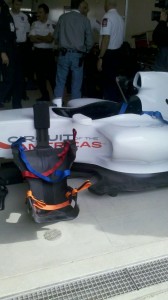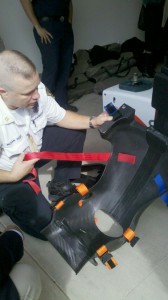Formula One–where speed and safety meet

You might be surprised to learn that a sport known for its high speeds was founded in safety, but that's exactly how Formula 1 got its start. Back in the beginning days of motor car racing, there were no limits placed on the size and power of the cars' engines. Combine this with the fact that cars were run on public streets, and races became quite dangerous. The governing body of auto racing at the time began to impose rules on the size and power of cars; after World War II, the cars that met these criteria and raced according to these rules became known as "Formula One." The rules govern not only how the race is held but the very technology of the cars themselves (and that technology is perhaps the true competition in F1, which is why there are two prizes to be claimed: the Constructors' Championship, which Red Bull is currently leading with 422 points, and the Drivers' Championship, led by Sebastian Vettel of Red Bull with 255 points–though Ferrari's Fernando Alonso is a close second with 245, making Sunday's race very important).
It's really not a surprise, then, that Austin's Circuit of The Americas is taking safety seriously. The Medical and Safety Services staff is led by Dr. Stephen Olvey, who has a long history with providing medical support on the motorway. He's the author of a book, Rapid Response: My Inside Story as a Motor-Racing Life Saver, which begins with Alex Zanardi's horrific CART racing crash in 2001 (he survived, though he lost both legs; Zanardi recently participated in the 2012 Paralympics and took a gold medal in cycling) and relates Dr. Olvey's experience and history with motor sport support.

Dr. Olvey stated that fans at race day are "better off having a heart attack here [at CoTA] than at home" as he related the many state of the art safety procedures and protocols that have been put in place for both spectators and participants. There is the main Medical Center, located near the Main Grandstand, complete with the necessary equipment for an "urgent care" facility, all of which has been, according to Dr. Olvey, "battle tested" in military operations. It is staffed by four medical specialists, two emergency medical technicians, and two critical nurses. Perhaps one of the most important features is the helicopter pad, which can transport the seriously injured directly to Brackenridge's renowned Trauma Center in a mere three minutes. In addition to the main trauma center, there are seven aid stations placed around the event grounds, each staffed by two advanced response medical paramedics and two critical care nurses. In the event of a fatality, there is a "quiet room" for family located within the Medical Center. While there has not been an F1 fatality during a Grand Prix race since Aryton Senna's death in 1994 (side note: the documentary, "Senna," is an excellent movie and a great introduction to the sport and this legendary driver. His nephew, Bruno Senna, is currently a driver for the Williams F1 Team), it is important to be prepared for all cases. "I wake up in the middle of the night thinking of possible scenarios," stated Dr. Olvey. Those scenarios include health problems for spectators, as these same services are available to all who may need assistance, free of charge, while attending the events–not just those racing.

The emergency response crews are made up of Travis County Fire and Rescue responders as well as Austin-Travis County Emergency Medical Services personnel, all of whom have had special training in the art of F1 crash response. One of the key issues is that, in the event of a crash, the race does not stop. The yellow flag, which signifies no passing, is given, but cars are still flying by as responders work quickly to assess and react to what they find at the crash scene.
One of the interesting aspects in race emergency care is extracting the driver from the car. An F1 car has a carbon-fiber chassis and round pipe framing, both of which are different from the average car. Division Chief James Hawley (Austin-Travis County Emergency Medical Services) and Battalion Chief Adan Torres (Travis County Fire Rescue) explained that many of the same procedures used in a roadside wreck will still be applied to an F1 crash scene: Responders will quickly assess the situation and contain fuel as needed. While responders have special tools to deal with the unique materials and construction of the cars, don't expect to see a driver cut from the wreckage. F1 cars are designed so that they are essentially molded around the drivers' bodies and part of that construction includes lightweight, carbon seats that can be removed with the driver in place. The emergency response teams have practiced these extractions with an actual F1 car frame and stand-in "driver" so that they have the routine down, which involves about ten steps performed by a team of five to six responders. Because of the possibility of spinal injuries, great care is taken to immobilize the driver's head and he is placed on a special inflatable stretcher which conforms to his body before the seat is removed to minimize any unnecessary shift in position. In the event of injuries that cannot be treated on site, the helicopter will pick up the driver on the track to transfer him to Brackenridge. "There's no reason to move someone to our Medical Center only to wait to move again to the Trauma Center," reasoned Dr. Olvey. "Time is important."
With CoTA being an untested track, it's hard to know exactly where the trouble spots for drivers might be. Lon Bromley, director of safety at CoTA, pointed out that every Circuit is unique and each has its special challenges. He sees the high speeds at Turns 1, 10-11, and 11-12 as being areas to watch for.
It's good to know that, whatever race day brings, the Medical and Safety Services at Circuit of The Americas are well-equipped to handle any and all emergencies with expertise.






